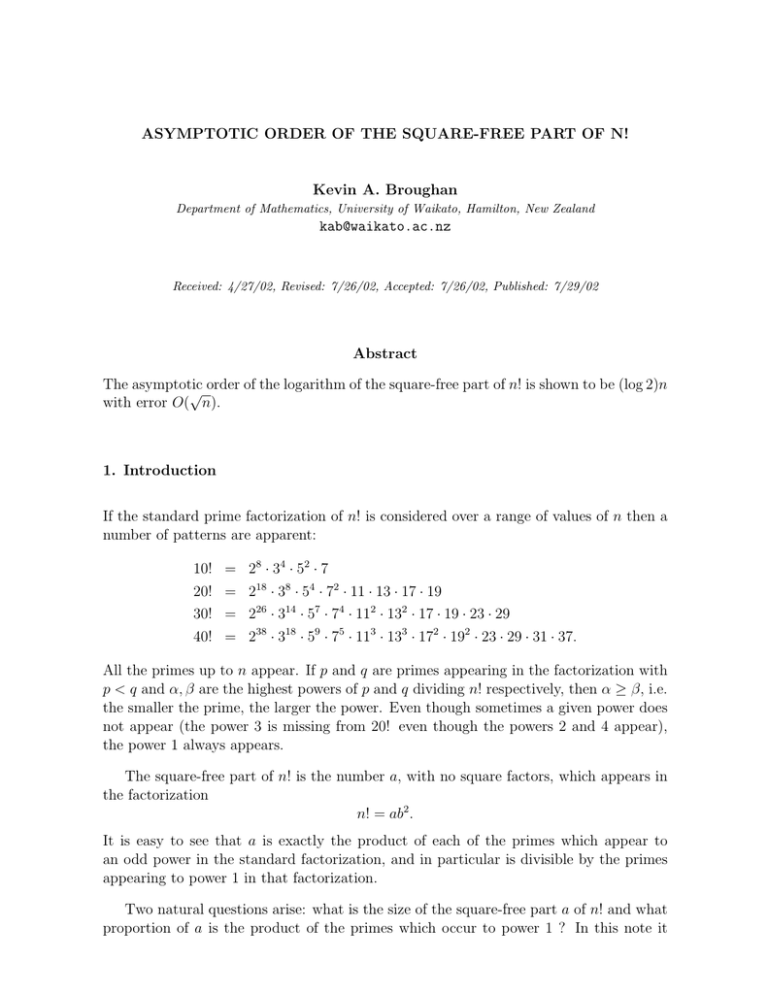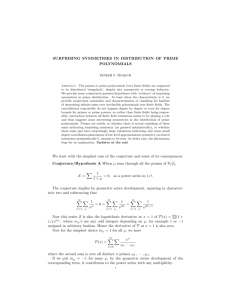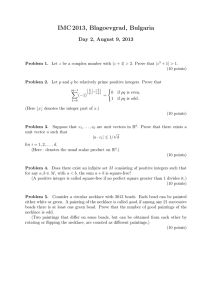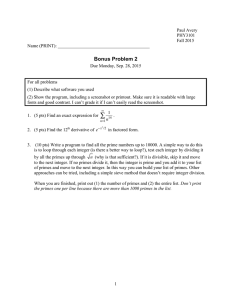ASYMPTOTIC ORDER OF THE SQUARE-FREE PART OF N! Kevin A. Broughan
advertisement

ASYMPTOTIC ORDER OF THE SQUARE-FREE PART OF N! Kevin A. Broughan Department of Mathematics, University of Waikato, Hamilton, New Zealand kab@waikato.ac.nz Received: 4/27/02, Revised: 7/26/02, Accepted: 7/26/02, Published: 7/29/02 Abstract The asymptotic √ order of the logarithm of the square-free part of n! is shown to be (log 2)n with error O( n). 1. Introduction If the standard prime factorization of n! is considered over a range of values of n then a number of patterns are apparent: 10! = 28 · 34 · 52 · 7 20! = 218 · 38 · 54 · 72 · 11 · 13 · 17 · 19 30! = 226 · 314 · 57 · 74 · 112 · 132 · 17 · 19 · 23 · 29 40! = 238 · 318 · 59 · 75 · 113 · 133 · 172 · 192 · 23 · 29 · 31 · 37. All the primes up to n appear. If p and q are primes appearing in the factorization with p < q and α, β are the highest powers of p and q dividing n! respectively, then α ≥ β, i.e. the smaller the prime, the larger the power. Even though sometimes a given power does not appear (the power 3 is missing from 20! even though the powers 2 and 4 appear), the power 1 always appears. The square-free part of n! is the number a, with no square factors, which appears in the factorization n! = ab2 . It is easy to see that a is exactly the product of each of the primes which appear to an odd power in the standard factorization, and in particular is divisible by the primes appearing to power 1 in that factorization. Two natural questions arise: what is the size of the square-free part a of n! and what proportion of a is the product of the primes which occur to power 1 ? In this note it INTEGERS:ELECTRONIC JOURNAL OF COMBINATORIAL NUMBER THEORY 2 (2002),#A10 2 will be shown that, asymptotically, the square-free part of n! has order 2n and that the proportion of primes to power 1 is about 72%. 2. Integer Square Roots For each whole number n let the integer lower square root be defined by Y α r− (n) = pb 2 c pα ||n and the integer upper square root by Y α r+ (n) = pd 2 e . pα ||n If n = ab2 and cn = d2 with a and c square-free, then r+ (n) b = r− (n), d = r+ (n), a = c = . r− (n) This pair of functions r± is quite useful. They are multiplicative, can be generalized to integer k’th roots and are related to the integer conductor or square-free core. For examples and applications see [3, 4]. 3. Computing the square-free part of n! To obtain some idea of the behavior of the square-free part of n!, for large n, it pays to do some computations. However, for numbers of quite small size, say n = 400, n! is a number with over 800 digits, so finding the square-free part should not be attempted directly. The following strategy was adopted: For each n ≥ 1, let θn be the square-free part of n + 1, i.e., θn = r+ (n + 1)/r− (n + 1). Because an+1 b2n+1 = (n + 1)n! = (n + 1)an b2n and n + 1 = θn c2 for some integer c, we have θn an b2n = an+1 b2n+1 . If a prime p | (θn , an ), then p occurs as a factor in both θn and an , so must occur to an odd power in both n! and n + 1, and therefore to an even power in (n + 1)!. Hence it does not occur in an+1 . If a prime occurs in just one of θn and an , then it must occur in an+1 . This leads directly to the formula: (1) an+1 = an θ n . (an , θn )2 INTEGERS:ELECTRONIC JOURNAL OF COMBINATORIAL NUMBER THEORY 2 (2002),#A10 3 Note that this formula can be used to evaluate the sequence (an ) recursively, so the values of log an can be plotted, revealing a nice approximately linear dependence on n. See Figure 1. Figure 1. The sequence log an as a function of n. 4. Asymptotic orders The result of these computations of the square-free part of n! leads to two natural tasks: determining the slope of a line approximating the graph of log an , and finding an upper bound for the error in this approximation. The completion of both tasks is summarized in the next theorem. Theorem 1: For each n ∈ N let n! = an b2n where a1 = b1 = 1 and where for all n ≥ 1, an is square-free. Then and √ log an = n log 2 + O( n), √ 1 1 + log 2 log bn = n log n − n + O( n). 2 2 ¡ ¢ Proof: Consider the central binomial coefficient 2n = tn s2n where tn is square-free. n Then b22n a2n = (2n)! = (n!)2 s2n tn so tn = a2n for all n ∈ N . By the main result in [7], there is a real strictly positive constant c such that for all ² > 0 and all n sufficiently large √ √ (c − ²) n < 2 log sn < (c + ²) n. √ Therefore log sn = O( n). INTEGERS:ELECTRONIC JOURNAL OF COMBINATORIAL NUMBER THEORY 2 (2002),#A10 Stirling’s approximation for n! [8] is n! ≈ 4 √ 2πn(n/e)n . It leads to the formula: log n! = n log n − n + O(log n). µ ¶ 2n log a2n = log − 2 log sn n √ = 2n log 2n − 2n − 2n log n + 2n + O( n) √ = 2n log 2 + O( n). log a2n+1 = log a2n + log θ2n − 2 log(a2n , θ2n ) Consequently: By equation (1) = log a2n + O(log n) since θ = O(n) √ = (2n + 1) log 2 + O( n) √ log an = n log 2 + O( n). and therefore But, by Stirling’s approximation again and this estimate for log an : √ 2 log bn = n log n − n − n log 2 + O( n) √ = n log n − (1 + log 2)n + O( n) √ 2 and therefore log bn = 12 n log n − 1+log n + O( n). This completes the proof of the 2 theorem. ¡ ¢ , namely tn , satisfies log tn = 2n log 2 + It follows also that the square-free part of 2n n √ O( n), giving the asymptotic This relates to the solved conjecture of Erdős [5] ¢ ¡2norder. that the binomial coefficient n is not square-free for n > 4. It relates also to the parity of the exponents of the prime factors of n!, [2]. 5. Primes dividing n! Lemma 1: Let k ≥ 1 and let p be a prime integer. If n ≥ k(k + 1) then pk kn! if and n only if k+1 < p ≤ nk . Proof: If n k+1 <p≤ n k then k ≤ n p < k + 1, so therefore n k = b c. p Since k(k + 1) ≤ n we have k ≤ n k+1 b < p, so that k+1 n c< ≤ 1. 2 p p It follows that b pn2 c = 0, by Legendre’s formula ∞ X n n αp = b j c = b c = k. p p j=1 INTEGERS:ELECTRONIC JOURNAL OF COMBINATORIAL NUMBER THEORY 2 (2002),#A10 5 n Conversely, if pk kn! then k = b np c + · · · . Thus b np c ≤ k, which implies k+1 < p, so k < p. n n k n n In addition k < k+1 , therefore p2 ≤ p < 1 so b p2 c = 0 and k = b p c, which shows p ≤ nk . This completes the proof of the lemma. For x > 0 let X θ(x) = log p, 2≤p≤x Chebyshev’s function [1], where the sum is over all primes less than or equal to x. If x ≥ 563 then θ(x) is close to x in that [6] ¡ ¡ 1 ¢ 1 ¢ x 1− < θ(x) < x 1 + . 2 log x 2 log x If follows that if n ≥ nk ¡n¢ ¡ n ¢ n n |θ . −θ − |≤ k k+1 k(k + 1) k log nk By Lemma 1, the logarithm of the product of primes which appear in n! to the k’th power is Y X log p = log p n <p≤ n k+1 k n <p≤ n k+1 k ¡n¢ ¡ n ¢ −θ k k+1 ¡ n ¢ n + Ok , = k(k + 1) log n = θ so the asymptotic order of the product is n k(k+1) as n → ∞. Therefore, by Theorem 1, the asymptotic proportion of the square-free part of n! due to primes appearing to powers 1, 3, . . . , 2k − 1 is 1 − 12 + 13 − 14 + · · · + log 2 For example, primes to power one contribute one or three to 7/12 , log 2 1 2k−1 1/2 log 2 − 1 2k . or about 72%, and those to power or about 84% of the square-free part. Acknowledgments This work was done in part while the author was on study leave at Columbia University. The support of the Department of Mathematics at Columbia University and the valuable discussions held with Patrick Gallagher are warmly acknowledged. The contributions of a referee who, in particular, supplied the general case for Lemma 1, are also gratefully acknowledged. INTEGERS:ELECTRONIC JOURNAL OF COMBINATORIAL NUMBER THEORY 2 (2002),#A10 6 References [1] T. M. Apostol, Introduction to Analytic Number Theory, New York, Berlin Heidelberg: Springer-Verlag, 1976. [2] D. Berend, On the parity of the exponents in the factorization of n!, J. Number Theory 64 (1997), 13-19. [3] K. A. Broughan, Restricted divisor sums, Acta Arithmetica, 101 (2002), 105-114. [4] K. A. Broughan, Relationships between the integer conductor and k’th root functions, (preprint). [5] A. Granville and O. Ramaré, Explicit bounds on exponential sums and the scarcity of square-free binomial coefficients, Mathematica 43 (1996), 73-107. [6] J. B. Rosser and L. Schoenfeld, Approximate formulas for some functions of prime numbers, Illinois J. Math. 6 (1962), 64-94. [7] A. Sárközy, On divisors of binomial coefficients I, J. Number Theory 20 (1985), 70-80. [8] http://mathworld.wolfram.com/StirlingsSeries.html.








